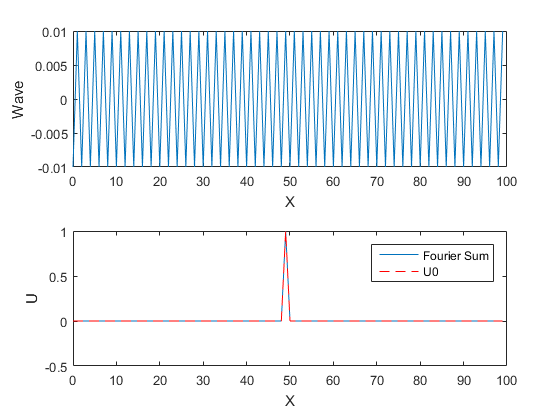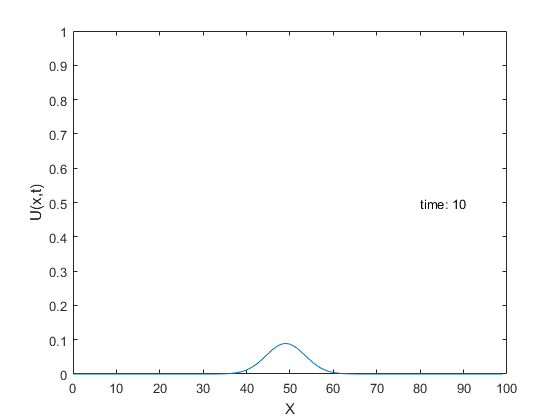PDE Example: Diffusion in a box (Same as heat)
We look the time-evolution of the distribution of small particles as they spread due to diffusion, but are confined to a 1D box. The box has length L.
The Diffusion equation is:
Contents

Boundary conditions for the closed box case are:

We can see that the following is a solution to the differential equation:

where  are determined by the intial distribution
are determined by the intial distribution  .
.
%Setup problem and initial state L=100; %Length of box D=1; %Diffusion Constant U0=zeros(1,L); %This is our t=0 particle distribution u(x,0) U0(50)=1; %Make this a delta function (we dropped a small drop of ink into the middle of 1D glass of water) X=(0:L-1); N=length(X) %Calculate the Coefficients A0=1/L*sum(U0); for nn=1:N-1 An(nn)=2/L*sum(U0.*cos(nn*pi*X/L)); end An(N)=1/L*sum(U0.*cos(N*pi*X/L)); %Note the special end cases. This correction is required to to exactly represent the U0 using an %orthognal set of cosine base functions. The term An(N) is different in the %discrete sampling case. % Calculates a term in the series sum. DiffEq = @(A,t,n,x)A*exp(-(n^2*D*pi^2*t/L^2))*cos(n*pi*x/L); %Show the series sum to represent U0 X=(0:L-1); t=0; U=A0; figure for nn=1:N Wave=DiffEq(An(nn),t,nn,X); U=U+DiffEq(An(nn),t,nn,X); subplot(2,1,1); plot(X,Wave) xlabel('X');ylabel('Wave') subplot(2,1,2); hold off plot(X,U) hold on; plot(X,U0,'r--'); xlabel('X');ylabel('U') %pause(.01) end legend('Fourier Sum','U0')
N = 100

Show the time evolution:
We simply evaluate the series at different time points.
figure for tt=0:.1:10 U=A0; for nn=1:N U=U+DiffEq(An(nn),tt,nn,X); end plot(X,U) xlabel('X');ylabel('U(x,t)') s=sprintf('time: %g',tt); text(80,.5,s); axis([0 L 0 1]) %pause(1) end
